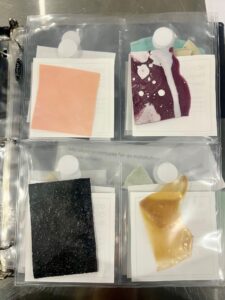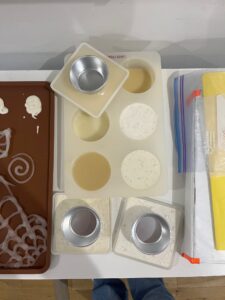Week 6: Biomaterial Experimentation, Liquid Cultures
May 3, 2024
Welcome to Week 6!
After flipping through a binder of biomaterial recipes Genspace has (see image below),

I decided to experiment with some for fun considering that part of my project was to learn about existing biomaterials. Specifically inspired by bioplastics, given their smooth texture and glossy finish (characteristics the mycelium lacks), a group of us at the Biomaterials Studio set out to try four, slightly different recipes. To recap, biomaterials are materials derived from biological sources or engineered to interact with biological systems. They’re utilized in a wide range of applications, including medicine, tissue engineering, consumer products, etc. Bioplastics are a subset of biomaterials, referring specifically to plastics derived from renewable biomass sources such as plants, algae, or bacteria. For anyone interested, the peer-reviewed scientific journal Biomaterials Science publishes work covering a wide range of topics related to the design, synthesis, characterization, and applications of biomaterials in various fields!
After measuring the various ingredients, we combined them over heat, until the solution reached boiling point, and then poured it into a couple molds (we also tried a couple with syringes). As an example: one involved 250 mL of water, 8 grams of agar, 4 grams of beeswax, 2 grams of glycerol, and 2 grams of chitosan. We switched around some of the ingredients; some had beef gelatin, others didn’t, and each had varying amounts of sodium alginate.



Prior to this project, I had little to no understanding of bioplastics and am considering incorporating them into my project somehow (possibly trying some more recipes for the watercolor pans that would then be encapsulated by the mycelium).
Given the mold growth on the agar plates (see last week),  I mentioned liquid mycelium cultures. Liquid mycelium cultures are prepared using a nutrient-rich liquid medium that provides the essential nutrients and energy sources for the mycelium to grow and proliferate. Common ingredients in the nutrient solution may include sugars (such as glucose or malt extract), nitrogen sources (such as yeast extract or peptone), vitamins, and minerals. The nutrient solution is sterilized to eliminate any competing microorganisms that could inhibit fungal growth. Once the liquid mycelium culture has reached a sufficient level of growth, it can be used to inoculate substrates for mushroom cultivation. This week I experimented with a king oyster liquid culture and a pink oyster liquid culture on agar plates to test before inoculating my substrates (which will be pasteurized first) with them.
I mentioned liquid mycelium cultures. Liquid mycelium cultures are prepared using a nutrient-rich liquid medium that provides the essential nutrients and energy sources for the mycelium to grow and proliferate. Common ingredients in the nutrient solution may include sugars (such as glucose or malt extract), nitrogen sources (such as yeast extract or peptone), vitamins, and minerals. The nutrient solution is sterilized to eliminate any competing microorganisms that could inhibit fungal growth. Once the liquid mycelium culture has reached a sufficient level of growth, it can be used to inoculate substrates for mushroom cultivation. This week I experimented with a king oyster liquid culture and a pink oyster liquid culture on agar plates to test before inoculating my substrates (which will be pasteurized first) with them.
See you next week!
Reader Interactions
Comments
Leave a Reply
You must be logged in to post a comment.

It’s really interesting seeing your project progress. Aside from the use in watercolor pans, are there any other uses for bioplastics that could be relevant to your project? Is it possible they could serve as a substitute for the mycelium itself?
Yes, the entire product could have technically been made of bioplastics! Since my project focuses so heavily on mycelium, though, if I end up incorporating them, it’ll be alongside the mycelium.